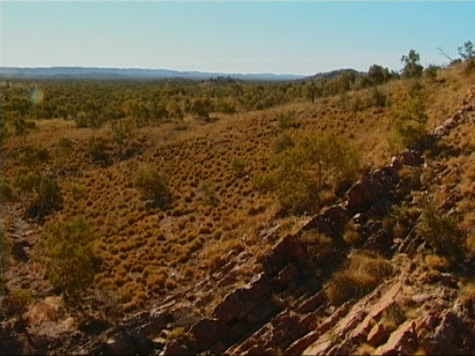21 August, 2001
Southwest of Mt. Isa
In our tour of the bush yesterday, David Nardoo of the Kalkadoon Aborigine Tribe taught us all about the foods that native people would have found in the harsh climate of western Queensland to survive. “Bush tucker,” they call it out here. He showed us a native banana tree, various berry bushes, lemongrass and even soapweed, which could make soap just by adding a little water. Then he took us to eucalyptus trees filled with bees and honey and had us eat the grubs he pulled out of the bottom of a turpentine tree. Before the tour we saw nothing but an unwelcoming, dry spinifex desert that could barely sustain a kangaroo rat. Afterward, it seemed like a world of abundance.

The aborigines did all their living off the land. They competed directly with birds and other animals for the food that was available. Fortunately, being omnivores, they had many different foods available to them besides those offered by plants and insects. They could also hunt emus and kangaroos and snakes. Still, their population would have been limited by the food and water resources available over the course of the year, both of which are in incredibly short supply in the winter season. Those same limits would only allow for a very small number of animals to hunt.
Today, across most of the globe, it seems as if we have very few limits to population growth. Humankind has conquered many diseases. This has allowed the average lifespan to increase. Older people are living longer and healthier lives. Infant mortality has been lowered. Technological innovations in food production have also allowed us to cultivate more food than we actually need and distribute it across the world. Today, you can live in a desert that has no food resources whatsoever and still have easy access to ice cream, pie or breakfast cereal.
Still, there are some that say that there is a limit to our human population growth. These people suggest agricultural land is losing its fertility and that we couldn’t possibly continue to feed the world’s population as it grows past 6 billion. They might suggest, too, that as environmental degradation increases with the human population growth, it will take its toll on human and animal populations, affecting the health and numbers of both. Some thought we would be facing widespread problems with food shortages and disease already. Others say we are facing such problems right now.
Still, there are some who believe that technology will save the day, that we will find new and better ways to produce food over time and that food shortages will never be anything to fear.
Suggested Learning Activity:
Write about your thoughts on this issue. Do you think technology will save the day? Should we be concerned at all? Can the earth handle many more people or are there too many here already?